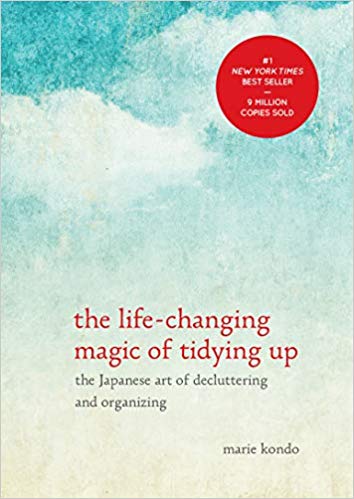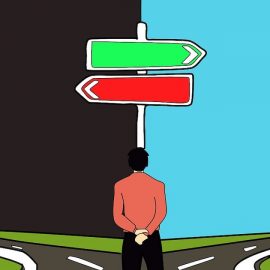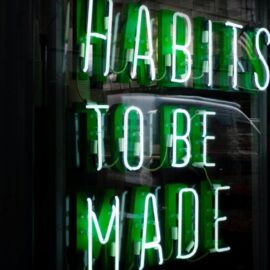

This article is an excerpt from the Shortform summary of "The Life-Changing Magic of Tidying Up" by Marie Kondo. Shortform has the world's best summaries of books you should be reading.
Like this article? Sign up for a free trial here .
Have too much stuff, and not sure how best to get rid of it? Marie Kondo is a world-renowned expert on tidying (you might have heard of her book or Netflix show), and her famous book teaches you how to get past the most common barriers preventing you from decluttering.
Go through the Konmari method once, and you may find your relationship with things to be changed permanently.
Why Should I Tidy Using the Konmari Method?
Let’s start with the high-level mindset. Marie Kondo believes tidying is magic because, if done right, it can transform your whole life: a dramatic reorganization of our home can lead to dramatic changes in other areas.
For example,our unwillingness to discard something usually indicates either an attachment to the past or anxiety about the future. We all want to remember our past and we all want a stable future–but when we let attachment to the past or anxiety about our future dictate our decisions, we focus on everything but the present.
- If you discover, through tidying, that you have a deep attachment to the past, it’s probably affecting other areas of your life, like your job and your relationships. Same goes for anxiety about the future.
- There are only three ways to deal with your belongings: do it now, do it sometime, or avoid it until you die. It’s better to face things now, if we can, so that we don’t have to deal with them later.
The best tools for maximum organization are awareness and values. Being aware of your ideal lifestyle and knowing the values you want to align your life with are more important than any ability to sort objects.
This might sound serious, but tidying is fun! You’re learning about yourself, assessing your belongings, and working to create a home and lifestyle that’s exactly what you want it to be. By tweaking your mindset, you can be the master of significant change in your own home and life.
The way we achieve the right mindset is by following the right technique.
Chapter 2: The Big-Picture Process
Tidying is really just the sum of two physical acts: 1) deciding whether you want to keep something, and then 2) deciding where to put it. If you do these two simple things the right way, you can actually achieve perfection in your home.
Here’s the KonMari method, at the highest level:
- Get all your belongings in a single category (eg clothing) across your entire home, and put them in one pile in the same room.
- Pick up each individual item, and decide whether to keep or discard it.
- For the items you keep, organize them effectively.
- Move on to the next category (eg books).
KonMari goes through five categories in specific order: Clothing, Books, Papers, Miscellany, and Sentimental Items. As we’ll explain later, this saves the hardest emotional items to discard for last.
This sounds easy, but in practice you’ll find it hard to discard items and to confront how much stuff you have (which is why you own more stuff than you need right now).
The rest of this summary is about how to execute these steps effectively. You’ll learn how to get over the psychological hurdles that prevent you from tidying to the most effective extent.
Here’s what to expect:
- In this chapter, we’ll discuss the overall process and mindset.
- In chapters 3 and 4, we’ll discuss general principles of discarding and organizing that apply to all categories. We’ll discuss common psychological barriers you might face.
- Then we’ll have a chapter on each of the five categories, to deal with issues specific to that category.
Ikki Ni – In One Go
Ikki ni, in Japanese, means in one go, and this is an important facet of the process: do it all in one go.
In the KonMari method, tidying “all in one go” means:
- Taking all your items of a category in your entire house and putting it in one pile, instead of going closet by closet or room by room.
- Sorting through the whole pile, picking up each item and deciding what to keep and what to discard.
- Organizing what you keep in the storage space available to you.
Ideally, you’d discard and organize a whole category, start to finish, in one sitting, and then do categories back to back as soon as possible.
But most of us have jobs and responsibilities that prevent us from tidying this way, so “in one go” really means powering through the process as much as you can in the time you have available to do it.
- Kondo advises that “all in one go” can still mean the process takes you up to 6 months total, tidying when you have the long stretches necessary to do so. But it’s only 6 months out of your whole life to get your space in order and make a change that will affect the rest of your life positively.
A lot of organization advice says that you can make tidying easier by doing a little bit at a time. But this doesn’t make it easier, it makes it harder, and it makes you more likely to rebound back into clutter.
- Doing it little by little makes us feel like we’re organizing, when in reality we’re just doing things halfway and unfinished.
- If we tidy just a little bit every day, we’ll be tidying for the rest of our lives, and who wants to do that?
- It’s easy to lose momentum this way, and it takes more energy over a longer period of time.
- This is why it’s better to do it as a marathon: tidy up in one go. This makes sure you finish the job completely, which prevents you from rebounding.
The kind of big-picture tidying Kondo talks about shouldn’t be done every day. She views this kind of tidying as a special event. Special event tidying should be done in a short amount of time while your spirits are high, while daily tidying should consist of putting the things you use back where they go. Only once you’ve completed the special event task can you actually do the daily tidying effectively and without much effort.
Tidying all in one go helps you see the most dramatic results fastest–and this is the easiest way to change your mindset. You’ll know what it feels like to have a house that’s totally organized to your own standards, and you’ll be surrounded by objects that make you happy. Why would you ever want to go back to a cluttered life after that?
Go by Category
This is a fatal mistake most people make while tidying: going by room instead of by category.
Most of us have similar items in different locations, like coats in a coat closet in the hall and clothes in a dresser in the bedroom. If we tidy by room, we end up doing the same kind of work over and over–this can lead to burnout.
Tidying by category lets us do one kind of work in totality, no matter where the objects are in your space. Plus, most of us have no idea how much stuff we own, so tidying by category is the wake up call we need…
———End of Preview———

Like what you just read? Read the rest of the world's best summary of Marie Kondo's "The Life-Changing Magic of Tidying Up" at Shortform . Learn the book's critical concepts in 20 minutes or less .
Here's what you'll find in our full Marie Kondo summary :
- The psychological benefits of tidying
- How to Tidy the Konmari method
- How to deal with Clothing, Books, Papers, and Sentimental Items
- ...and much more






